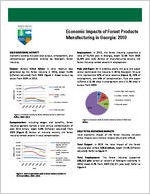Economic Impacts of Forest Products Manufacturing in Georgia: 2010
2010 ECONOMIC ACTIVITY Economic activity includes total output, employment, and compensation generated directly by Georgia's forest industry.
Employment: In 2010, the forest industry supported a total of 43,425 jobs in Georgia, down 10.5% from 2009 (5,094 jobs lost). Across all manufacturing sectors, the forest industry ranked second in employment.
Output: Almost $14.5 billion in total revenue was generated by the forest industry in 2010; down 15.6% (inflation adjusted) from 2009. Figure 1 shows output by sector from 2004 to 2010.
Million USD
$12,000 $10,000
$8,000 $6,000 $4,000 $2,000
$0
Forest Mgt. and Logging
Lumber, Veneer, Panels
Secondary Products
Year
Pulp and paper
Figure 1. Economic activity by forest industry sector in 2010 real dollars, 2004--2010.
Compensation: Including wages and benefits, forest industry workers earned a total annual compensation of over $2.6 billion, down 6.8% (inflation adjusted) from 2009 (Figure 2). Across all industry sectors, the forest industry ranked second in total compensation.
Million USD
30,000 25,000 20,000 15,000 10,000 5,000
0
Year
Forest management, logging, and misc. forest products
Lumber, veneer, panels, engineered wood
Secondary wood products, containers, machinery
Pulp and paper
Figure 2. Total compensation paid to forest industry workers in 2010 real dollars, 2004--2010.
Pulp and Paper: As in previous years, the pulp and paper sector dominated the industry in 2010; Georgia's 12 pulp mills represented 67% of total revenue (Figure 3), 40% of employment, and 54% of compensation. Pulp and paper suffered a 10.5% drop in employment and a 13.7% drop in output from 2009.
6% 13%
14% 67%
Forest Mgt. and Logging Lumber, Veneer, Panels Secondary Products Pulp and paper
Figure 3. Revenue share by forest industry sector in 2010 real dollars.
2010 TOTAL ECONOMIC IMPACTS Total economic impact of the forest industry includes direct impacts plus indirect impacts (multiplier effect).
Total Output: In 2010 the total impact of the forest industry was almost $23.6 billion, down 14.5% (inflation adjusted). Refer to Figure 4.
Total Employment: The forest industry supported 108,112 jobs across all sectors of Georgia's economy in 2010, down 8.7% from 2009 (10,311 jobs lost). Refer to Figure 4.
Total Compensation: In 2010, the forest industry supported annual wages and benefits equal to almost $5.4 billion, down 4.9% (inflation adjusted) from 2009.
Million USD Jobs
35,000 30,000 25,000 20,000 15,000 10,000 5,000
0
2003 2004 2005 2006 2007 2008 2009 2010 Year
200,000 150,000 100,000 50,000 0
Nominal Dollars
2010 Dollars
Employment
Figure 4. Total economic ouput in nominal and 2010 dollars and employment, 2003--2010.
LOCAL ECONOMIC DEPENDENCE The forest industry plays a vital role in supporting local economies and rural livelihoods throughout Georgia. The economies of 47 counties are moderately-to-critically dependent on the forest industry based on both employment and income. Figure 6 show employment dependence by county in 2010.
Since 2007, total output supported by the forest industry has decreased, trailing reductions in employment and compensation that began in 2006. In 2010, employment continued to shrink. On a more positive note, although compensation continued to decrease, it did so at a significantly lower rate (Figure 5).
15.00% 10.00%
Annual Percent Change
5.00%
0.00% -5.00% -10.00% -15.00%
Output Employment Compensation
-20.00%
Year
Figure 5. Year-to-year percent change in total output , employment, and compensation supported by the forest industry in 2010 dollars. Adapted from Riall, 2011.
Figure 6. Degree forestry-related dependence by employment percentage. From Riall, 2011.
2010 FISCAL IMPACTS In 2010, the forest industry generated $448 million dollars in tax revenue for the state of Georgia. Net revenue for 2010 from the forest industry (state revenue minus state costs) totaled over 165 million.
REFERENCE Riall, B.W. Economic Benefits of the Forestry Industry in Georgia: 2010. Enterprise Innovation Institute Report. Georgia Institute of Technology, 2011.
An Equal Opportunity Employer and Service Provider
